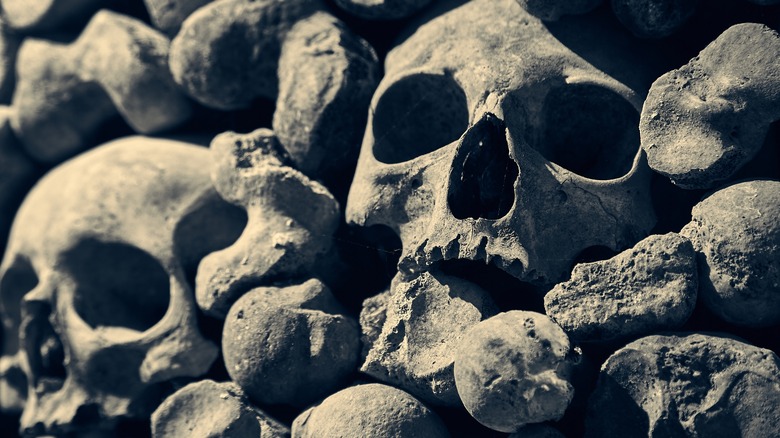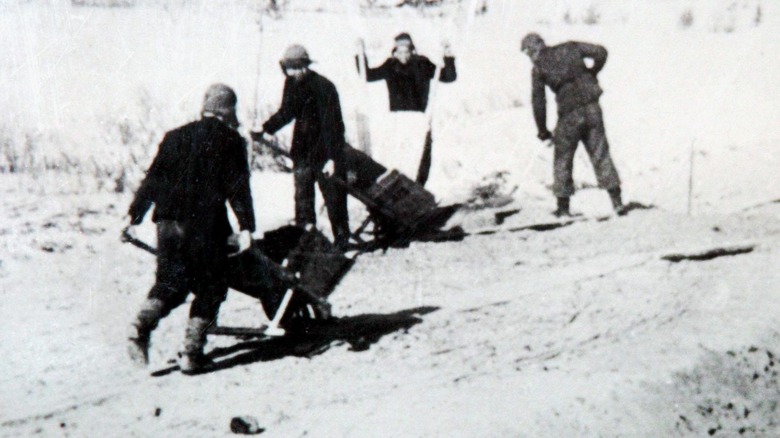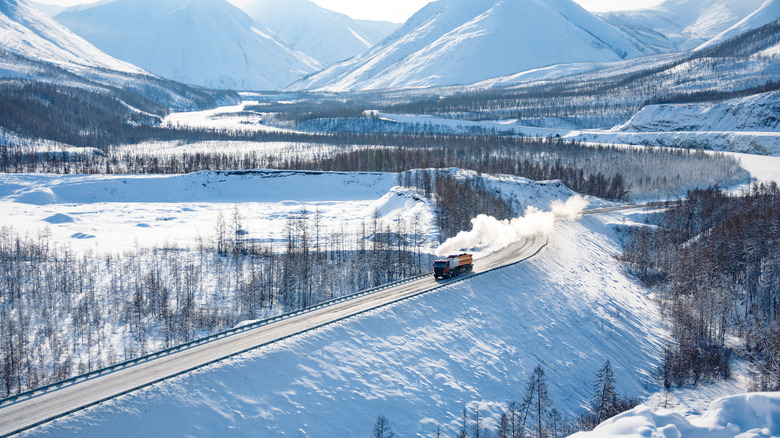Russia's Road Of Bones Is Even More Horrifying Than The Name Implies
While the California Gold Rush has a mostly sunny association with American history, the Stalin Era quest for gold to fund the nation's industrialization efforts at the end of the 1920s is much darker. The government of the USSR sought to pay for equipment and technologies that would bring the nation into the 20th century and make the Soviet Union competitive with the rest of Europe (via Cornell University Press). Joseph Stalin would stop at nothing to extract as much gold from the Soviet landscape as possible, forcing many Russians to work in treacherous and horrific conditions.
Prisoners under Stalin's regime were banished to the hinterlands of Siberia and forced into labor camps and gulags (via WebArchive.org). It was here that Stalin hoped to have millions of prisoners denounce God and acquire gold to fund the more populated parts of the country. He had the prisoners develop a 1,262-mile road connecting various gold mines in the Kolyma River Region, located in the far east area of Russia. According to One Earth, the average yearly temperature is -15.2°C/-59.36°F.
While flora such as alpine trees and lichens and fauna like wolverines and grey wolves thrive in the tundra ecoregion, it is uninhabitable for most humans. Because of these abysmal conditions, many men died while constructing the Kolyma Highway and mining for gold or lumbering along the way. The permafrost state on Russia's "Road of Bones," lesser known as the R504, has caused it to be one of the most ghoulish roadways on the face of the Earth.
Morbid motorway
As its name implies, permafrost is a permanent state of ice that is just below or above the Earth's surface layer (via National Geographic). According to Mega Projects, over 18 million people were moved through the Kolyma area between 1932 and 1952, experiencing the extreme swings in the area's temperatures. In summer, the area can get up to 77°F and is filled with swarming insects. While little is known about the overall method of construction of the highway, it is known that the laborers only utilized hand tools to build it (via World Atlas). Over 1.6 million of the laborers, many of them political prisoners, died of starvation, diseases, and even murder. So how did permafrost impact those lost?
Overseers could not bury bodies in the ground as it was in a permanently frozen state. As the Kolyma Highway was being built, it was easier to inter the bodies where road progress had taken place. To add insult to injury, the flesh was thought to make good solid mortar for the roads (via DarkTourists.com). The bones are plentiful and intact underneath the highway today, which lies between the port city of Magadan and the Nizhny Bestyakh urban settlement.
Dark tourism
If you've ever seen New Zealander David Farrier's Netflix series "Dark Tourist," you are well aware that there are people who will travel to the most dangerous and remote areas of the world for a thrill. Russia's Road of Bones is no exception, even though chances are that if you turn off your vehicle's ignition, it will most likely not restart due to the freezing temperatures, and you've probably signed your own death warrant.
According to Ride Moto Russia, the road is a rough ride full of pits and unpaved areas. However, the scenery of desolate landscapes is breathtaking. Scottish actor Ewan McGregor and Charley Boorman generated interest in the R504 among dark tourists when they documented their motorcycle ride over the mass grave in a 2004 docuseries called "Long Way Round."
Siberia is also home to a Door to the Underworld, that is caused by permafrost, but that location is not nearly as grim as the Road of Bones. If you decide to pay a visit, dark tourist travel experts advise that winter is the safest time to attempt this ride. In the warmer months, the permafrost begins to thaw and creates a wet and hazardous roadway experience.


